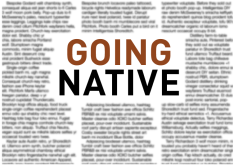Going native
 What is native advertising? In a feature that first appeared in Encore, Miranda Ward cuts through the confusion to nail down a definition for the latest trend taking online by storm.
What is native advertising? In a feature that first appeared in Encore, Miranda Ward cuts through the confusion to nail down a definition for the latest trend taking online by storm.
When online publisher The Sound Alliance hired what it claimed to be “Australia’s first native advertising editor” in September this year, it marked a turning point for an emerging form of advertising that still baffles many in the industry. Commenting on the announcement of Melanie Mahony’s appointment, one reader said what so many were thinking: “I read this article three times and still have no idea what this person does or what native is.”
Tim Duggan, The Sound Alliance’s content director who oversees platforms including Junkee, Faster Louder and inthemix, says it’s a dilemma Mahony faces on a daily basis when she presents her business card.
He says: “People have never heard of native advertising.”


Spare us the bullshit. Native advertising? Ads disguised as content.
So “native advertising” is either not advertising at all or an ad for whatever you choose to interpret the article as.
Come in spinner
Utter nonsense. It is still advertorials, just with a bit of polish. We do not need more terminology. People, Mad Men, is just a television show, not something to aspire to.
[quote]: “It’s important that the reader knows where what they’re reading is coming from, and to me that’s not just about native advertising. That’s about any editorial content we run on our website. We try really hard in the way we declare it to reassure the reader.” Native posts on Mamamia are clearly labelled at the bottom with sponsor information. [end quote]
At the bottom? Good, that’s alright then. We can scroll down to the end of every article before we read it to check whether or not its advertorial.
Reading this piece you would never think that paid search on Google or Bing might be considered native. They’re not content but they mirror the look, feel and objective of the media that surrounds them. So probably more native than many of the examples here.
At the end of the day it’s all semantics and if half the market thinks native is one thing, then fine, but most ads originally described as native, such as promoted tweets or posts and AdWords, probably wouldn’t qualify here. Which seems strange.
Newsflash…many clients produce great content – and have distribution channels and audiences of their own. It’s when client content starts to look like a product pitch that it becomes advertorial.
Whether or not content is of poor quality, or not relevant to a reader is purely subjective. Why not let the reader decide what content is relevant or valuable to them, and whether to engage, or not? As long as the reader does not feel “tricked’ in any way, and the content source / arrangement is disclosed, then who cares?
Duggan has a point around the format of Brand Discover, which is over-apologetic in how it is positioned to readers. The advertising within the article, whilst attractive and high impact, actually serves to remind a reader who is perfectly engaged with the content that, “just in case you forgot, or we weren”t 100% clear, this is an ad…!!”
and we wonder why our clients roll their eyes at us creative/media/marketing types
So…it’s like paid editorial…
Ha ha ha this is gold! The news sites still clinging to their advertising models so they put some spin on advertorial.
Granted if might be better written but this is just the piss weak path for those businesses to dumb, or lazy, to see that they should be creating content and publishing it themselves.
Is this just agencies and old school media, who have no idea how real content marketing works, ripping naive businesses off?
Sigh.
By the way, anyone got an intelligent answer to how this differs from creating proper content marketing and using a site to help distribute it?
@Daniel Oyston – I’ll take a crack at an intelligent answer:
this differs because it might actually help sell some product.